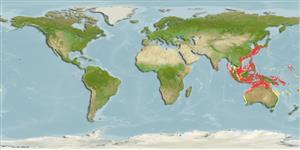Common names from other countries
Environment: milieu / climate zone / depth range / distribution range
Écologie
marin récifal. Subtropical
Western Pacific: Japan to Celebes, Indonesia.
Taille / Poids / Âge
Maturity: Lm ? range ? - ? cm
Max length : 16.0 cm SL mâle / non sexé; (Ref. 41299)
Épines dorsales (Total) : 10; Rayons mous dorsaux (Total) : 13 - 14; Épines anales: 3; Rayons mous anaux: 7.
Inhabits deeper rocky reefs (Ref. 41299).
Life cycle and mating behavior
Maturities | Reproduction | Spawnings | Egg(s) | Fecundities | Larves
Heemstra, P.C. and J.E. Randall, 1999. Serranidae. p. 2442-2547. In K.E. Carpenter and V.H. Niem (eds.) FAO species identification guide for fishery purposes. The living marine resources of the Western Central Pacific. Vol. 4. Bony fishes part 2 (Mugilidae to Carangidae). Rome, FAO. 2069-2790 p. (Ref. 39231)
Statut dans la liste rouge de l'IUCN (Ref. 130435)
CITES (Ref. 128078)
Not Evaluated
Menace pour l'homme
Harmless
Utilisations par l'homme
Outils
Articles particuliers
Télécharger en XML
Sources Internet
Estimates based on models
Preferred temperature (Ref.
115969): 15.6 - 27.6, mean 23.9 (based on 400 cells).
Phylogenetic diversity index (Ref.
82804): PD
50 = 0.5000 [Uniqueness, from 0.5 = low to 2.0 = high].
Niveau trophique (Ref.
69278): 3.4 ±0.4 se; based on size and trophs of closest relatives
Résilience (Ref.
120179): Haut, temps minimum de doublement de population inférieur à 15 mois (Preliminary K or Fecundity.).
Fishing Vulnerability (Ref.
59153): Low vulnerability (10 of 100).
